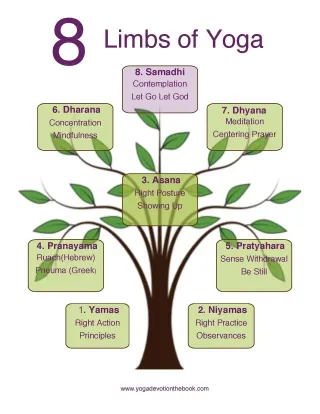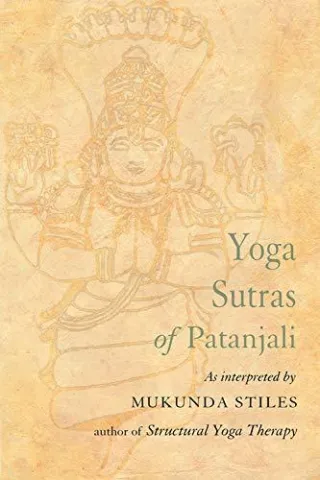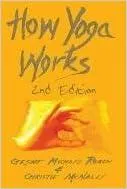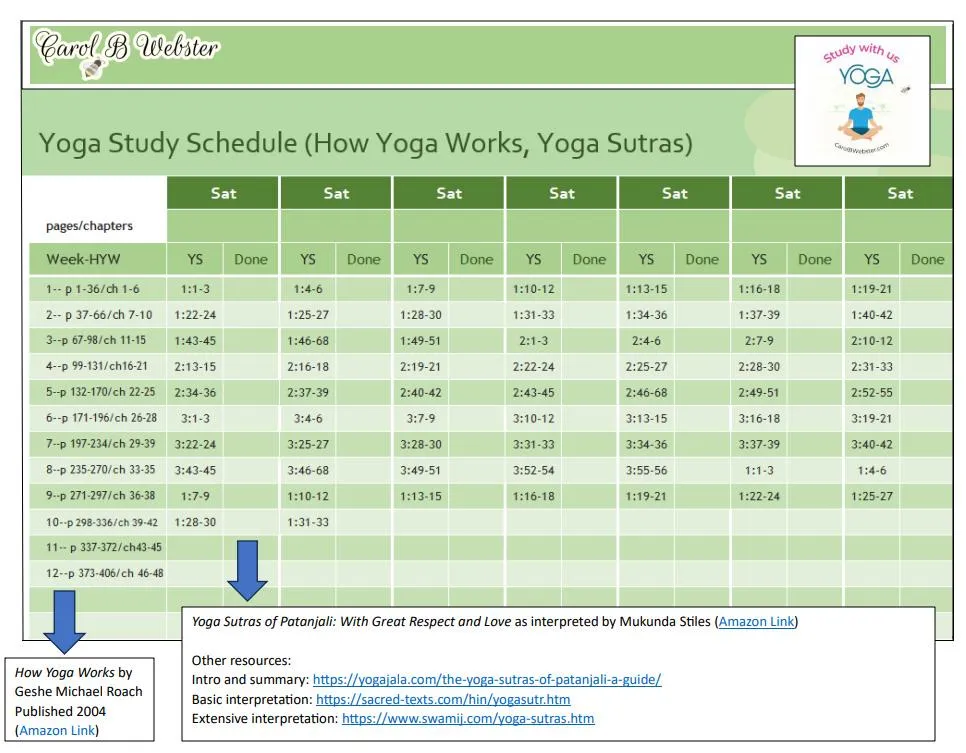
What is on this page?
Explanation of "8-Limbs"
What is the "Yoga Sutras"
About the book "How Yoga Works"
Current Syllabus
The 8-Limb Resources
When people hear the word "yoga" they generally think of a physical class where you learn poses. Maybe you have some notion that there is something more, but you aren't sure what that is or just how to learn more. Read on.
Yoga has more to do with the mind than the body. The poses help us "get the kinks out" and lead to better physical health. The point is, that it is very hard for the mind to function properly when one is in pain or has a foggy, sleepy feeling.
Learning the poses (called 'asana' in Sanskrit) is the 3rd Limb of Yoga. The 1st and 2nd Limbs are behavioral practices (called 'yamas' and 'nyamas'). The 4th is breathing practices (called 'pranayama'). The 5th is a practice of drawing your senses in so irritants don't bother you (called 'pratyahara'). The 6th and 7th are about focus and meditation (called 'dharana' and 'dhyana'). And the 8th is communion with God or a feeling of connection with the universe (called 'Samadhi'). Some call it is enlightenment or self-actualization.
It is not hard to understand what the 8-Limbs are; it is one thing to know what they are; it's an entirely different thing to apply them.
If you like a DIY approach to greater physical, mental, and emotional health, applying the 8-Limbs is invaluable.
The video below is a good overview I found on YouTube.
For a catalog with more related resources click here.

A short video introducing the 8-Limbs
The Yoga Sutras
The Yoga Sutras is a book or body of yogic knowledge attributed to someone named Patanjali who lived between the 2-4th century BC in India. (Some scholars believe it "Pantajali" was a group of scholars.)
It contains 196 Sutras (or verses), divided between four chapters. Like a gentle guiding hand, the Yoga Sutras explains the mind and its pitfalls and offer the means to overcome them.
To me, it reads like a psychology book. I can observe my own mind and find ways to access my deeper self and my relationship to my Creator.
I am a Christian. You may have a different religious background or no religious belief at all. Yoga is not a religion, but I guarantee ANYONE that applies these principles will be lead to a more productive and peaceful existence.
There are many translations of the Yoga Sutras. This one by Mukanda Stiles is the one my teacher gave me and we will use it as a base to study from.
This pdf has a side-by-side comparison of 4 translations. I really like this and refer to it a often when studying the Yoga Sutras. You may want to print this one.
Here is a link to a site with a really good intro and summary.
For an in-depth resource, try this website.
If you are fascinated by the mind as I am, I look forward to studying the Sutras with you.

A short video introducing the Yoga Sutras
How Yoga Works: a novel
Michael Roach writes a novel which weaves the Yoga Sutras into the fabric of a fictional story. For me, the plot makes me want to turn the pages, but the message demands that I pause and process the deeper meaning and application to my own life.
Set in 1101 AD in a tiny, cruel Indian village where minds are small and rigid, a young Tibetan woman and her dog pass by a guardhouse on her journey. She is stopped, falsely accused and put in prison where she is questioned about the book that she carries.
The prison Captain, sure that she has stolen the book, quizzes her. He stabbed his finger at the page, "Read what this says."
"Things that cannot last
Seem to us as if they will."
"What does that mean?" the Captain demands. "It is talking about our lives," she replies quietly. "Our friends, our family , our works, our own bodies. When they are there, in front of us--when we can see them, and touch them-- it seems as though they will always be there. But then they always leave us."
Reading this book for the first time more than a decade ago was captivating to me. It was more than reading, but it was more than just an interesting story. If you want more freedom and power in your life, get started on this book.
Copies of this book, both new and used, are easy to find. Here is a link to get you started to find a copy.

A short video introducing How Yoga Works
The Syllabus

This chart outlines a study the Yoga Sutras at the pace of 3 verses a day. This will take just over 3 months. How Yoga Works will be divided into weekly readings. Sample schedule:
Week 1: HYW p 1-36/ch 1-6
Day 1- 1:1-3
Day 2- 1:4-6
Day 3- 1:7-9
Day 4- 1:10-12
Day 5- 1:13-15
Day 6- 1:16-18
Day 7- 1:19-21
Week 2: HYW p 37-66/ch7-10
Day 1- 1:22-24
Day 2- 1:25-27
Day 3- 1:28-30
Day 4- 1:31-33
Day 5- 1:34-36
Day 6- 1:37-39
Day 7- 1:40-42
Week 3: HYW p 67-98/ch11-15
Day 1- 1:43-45
Day 2- 1:46-48
Day 3- 1:49-51
Day 4- 2:1-3
Day 5- 2:4-6
Day 6- 2:7-8
Day 7- 2:10-12
Week 4: HYW p 99-131/ch16-21
Day 1- 2:13-15
Day 2- 2:16-18
Day 3- 2:19-21
Day 4- 2:22-24
Day 5- 2:25-27
Day 6- 2:28-30
Day 7- 2:31-33
Click here
for PDF of full schedule

Dates for Online Yoga:

Cost:
Yoga is a priceless gift.
Carol's policy is that yoga should be available to anyone willing to do the learning regardless of financial status. Please honestly consider your budget and choose a donation level that works for you.
See button with current class info above for suggested donations
Copyright. All Rights Reserved. 2009-2025
